Have you ever stumbled upon guitar tabs brimming with strange symbols, leaving you more confused than excited to play your favorite song? If so, you’re definitely not alone. Many guitarists, especially beginners, find themselves initially perplexed by the seemingly cryptic language of guitar tablature.
However, understanding these guitar tab signs is crucial for unlocking a world of musical possibilities. Guitar tabs are a fantastic, user-friendly way to learn songs and guitar techniques. Mastering tab symbols is like learning the alphabet of guitar music – it empowers you to read, understand, and play countless songs.
This guide is designed to demystify guitar tab signs, turning those hieroglyphics into clear instructions. Whether you’re just starting your guitar journey or looking to refine your tab reading skills, this comprehensive breakdown will equip you with the knowledge to confidently navigate any guitar tab.
We’ll explore the different types of guitar tabs, decipher the meaning behind the numbers, and, most importantly, explain each symbol you’ll encounter. So, tune your guitar, get comfortable, and let’s decode the language of guitar tabs together!
Understanding the Basics of Guitar Tabs
Guitar tabs, short for tablature, offer a visual representation of music specifically for guitar. Unlike standard music notation which can be complex, guitar tabs use a simple system of lines and numbers to indicate which strings to play and where to fret them. This accessibility makes tabs an incredibly popular method for guitarists to learn and share music.
There are primarily three formats of guitar tabs you’ll encounter:
1. Text-Based Tabs: This is the most common and straightforward type. It uses six horizontal lines, each representing a guitar string. From bottom to top, these lines correspond to the low E, A, D, G, B, and high E strings. Numbers placed on these lines indicate which fret to play on that specific string.
2. Chord Diagrams: Chord diagrams are visual aids that show you exactly where to place your fingers on the fretboard to form a chord. They are often used in conjunction with text-based tabs, especially for beginners learning basic songs.
3. Standard Notation with Tablature: This format combines traditional musical notation with guitar tabs. The standard notation appears above the tablature, providing rhythmic and melodic information in a more conventional musical format, while the tab below offers the guitar-specific finger placements.
 Example of Standard Notation and Guitar Tabs Combined
Example of Standard Notation and Guitar Tabs Combined
When reading guitar tabs, remember to always read from left to right, just like reading text. The vertical lines you might see in some tabs represent measures or bars, helping to organize the music rhythmically, similar to measures in standard notation.
Deciphering Numbers in Guitar Tabs
Numbers are the core of guitar tabs, providing direct instructions on fret placement. Understanding how numbers are used is fundamental to reading tabs effectively.
Each number you see on a line corresponds to the fret you need to press down on that string. For instance, a “3” on the top line (high E string) means you should fret the 3rd fret of the high E string.
Let’s break down the common ways numbers appear in tabs:
1. Stacked Numbers: Playing Chords
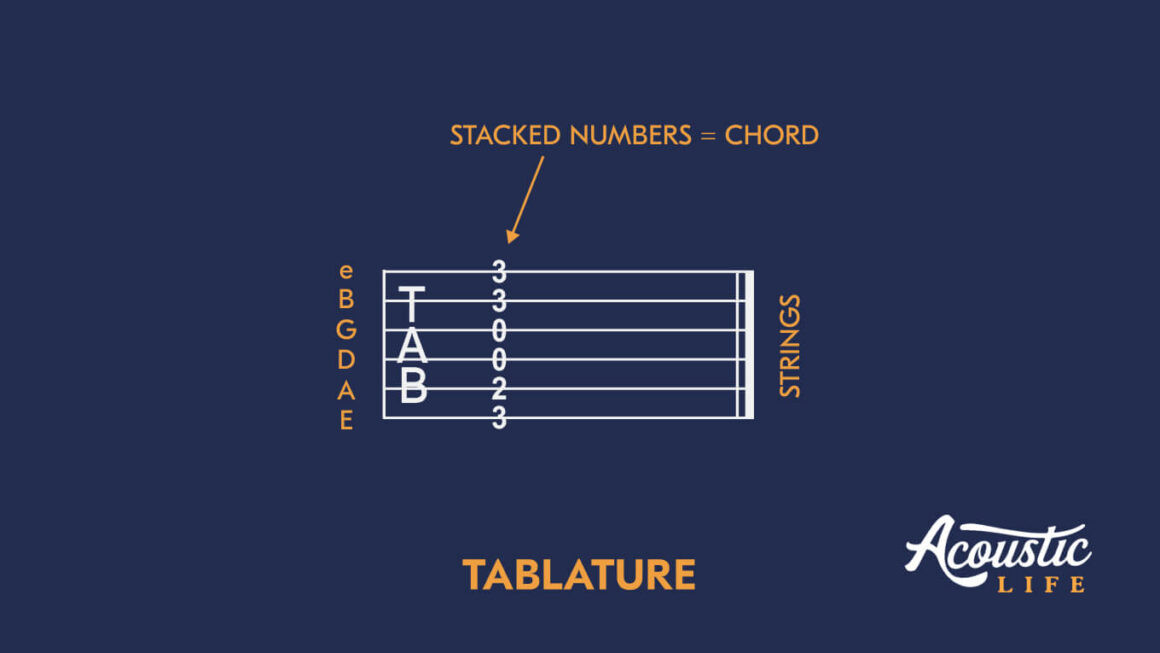 Example of Stacked Numbers in Guitar Tabs for a Chord
Example of Stacked Numbers in Guitar Tabs for a Chord
When you see numbers stacked vertically in a tab, it signifies a chord. Stacked numbers mean you play all those notes simultaneously, creating a harmonic sound. Each number in the stack applies to its corresponding string.
For example, the image above illustrates a G chord. You can see numbers stacked across multiple lines, indicating which frets to play on different strings to form the G chord.
2. Numbers in a Horizontal Line: Playing Melodies or Riffs
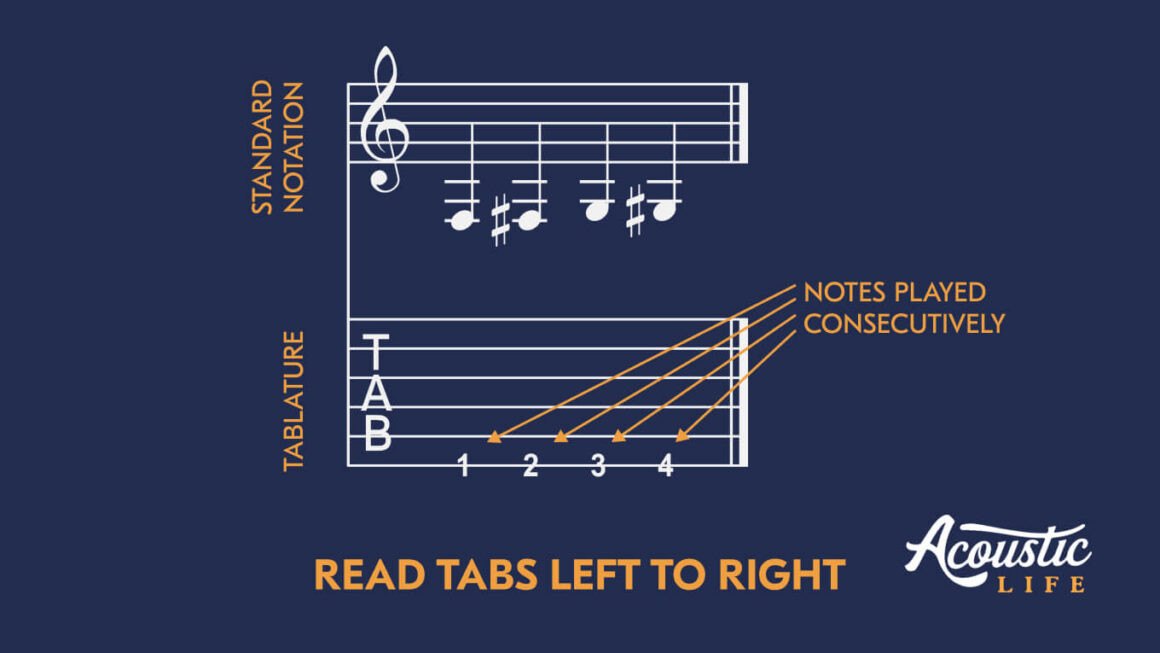 Example of Numbers in a Horizontal Line in Guitar Tabs for a Melody
Example of Numbers in a Horizontal Line in Guitar Tabs for a Melody
Numbers written sequentially from left to right indicate notes played one after another, forming melodies, riffs, or scales. You read these numbers in order, playing each note individually.
In the example, you would play the 1st fret on the low E string, then the 2nd, then the 3rd, and finally the 4th, creating a ascending sequence of notes.
3. The Zero: Playing Open Strings
 Example of Zero in Guitar Tabs Representing Open Strings
Example of Zero in Guitar Tabs Representing Open Strings
The number “0” in a guitar tab is straightforward: it represents an open string. This means you play the string without fretting any notes, letting it ring freely at its natural pitch.
The example shows a sequence of open strings: open low E, then open A, then open D, and so on across the strings.
Essential Guitar Tab Symbols and Techniques
Beyond numbers, guitar tabs use a variety of symbols to represent different playing techniques and nuances. These symbols are what truly bring tabs to life, allowing them to convey more than just basic notes. Let’s explore the most common and important guitar tab symbols:
1. Hammer-On (h or ^)
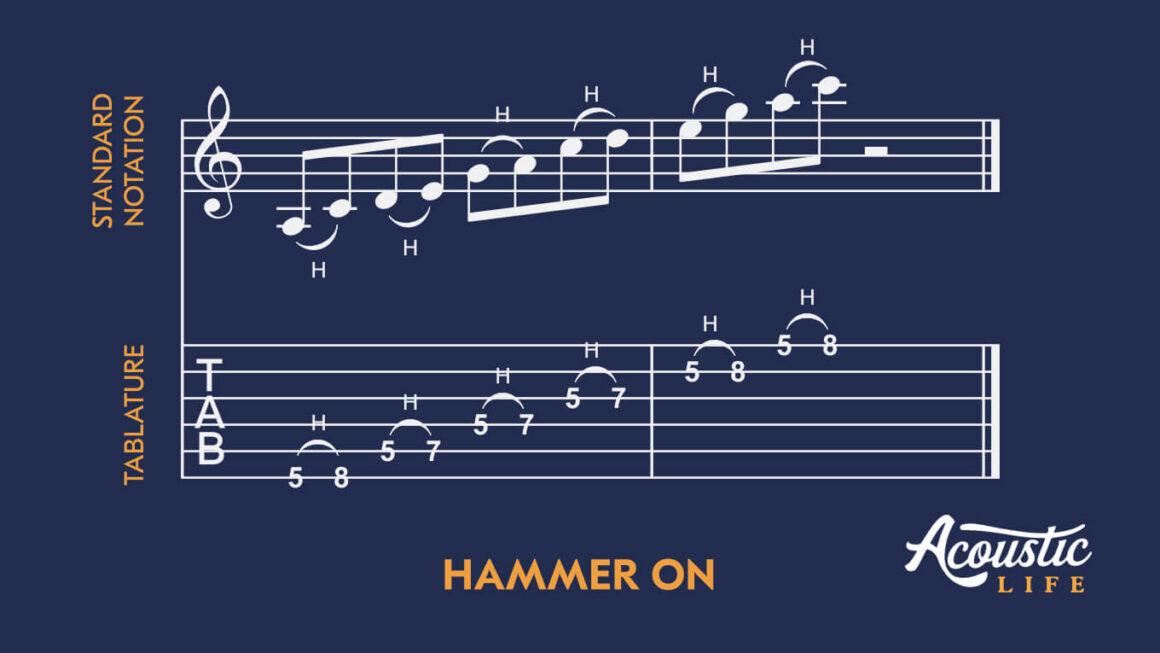 Example of Hammer-On Symbol in Guitar Tabs
Example of Hammer-On Symbol in Guitar Tabs
The symbol “h” or “^” indicates a hammer-on. This technique involves striking a fretted note with a finger from your fretting hand without picking the string again. It’s used to create a smooth transition between two notes.
For example, “5h7” means you play the 5th fret and then “hammer-on” to the 7th fret on the same string, using a finger from your fretting hand to create the 7th fret note without picking it.
2. Pull-Off (p)
The symbol “p” stands for a pull-off, the opposite of a hammer-on. To perform a pull-off, you fret a higher note and then “pull-off” your finger to sound a lower note on the same string, again without picking.
“7p5” would mean you play the 7th fret and then pull-off your finger to sound the 5th fret on the same string.
3. Slide Up (/) and Slide Down ()
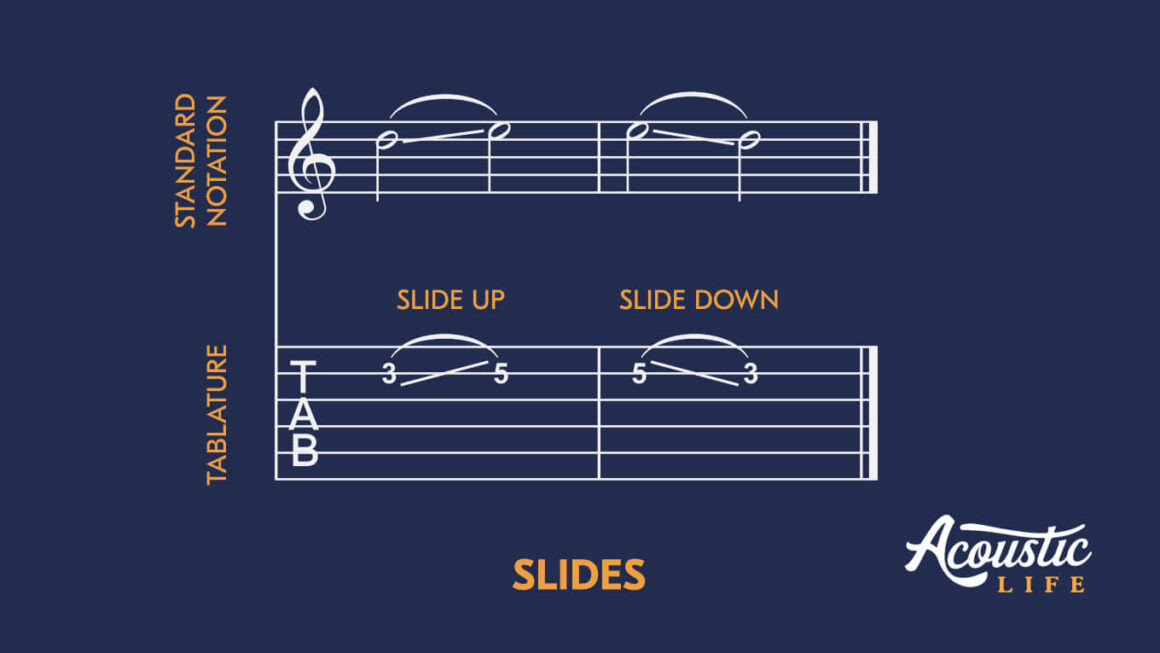 Example of Slide Symbols in Guitar Tabs
Example of Slide Symbols in Guitar Tabs
The forward slash “/” indicates a slide up, and the backslash “” indicates a slide down. A slide involves playing a note and then smoothly sliding your fretting finger up or down the fretboard to another note without lifting the finger from the string.
“3/53” means you play the 3rd fret, slide up to the 5th fret, and then slide back down to the 3rd fret.
4. Bend (b)
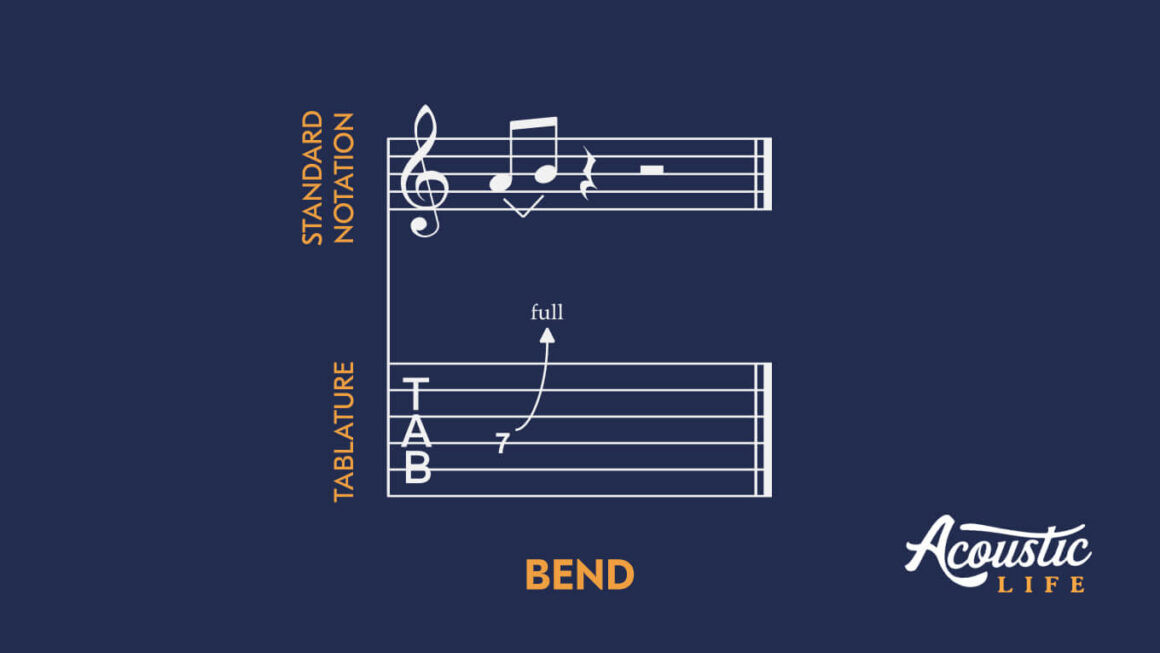 Example of Bend Symbol in Guitar Tabs
Example of Bend Symbol in Guitar Tabs
The symbol “b” represents a bend. Bending a string involves pushing or pulling it sideways across the fretboard to raise its pitch. Tabs often specify the degree of the bend, such as “full bend” (whole step) or “1/2 bend” (half step). Sometimes, bends are indicated with a curved line.
“7b9” means you play the 7th fret and bend the string up to the pitch of the 9th fret.
5. Mute or Dead Note (x)
 Example of Mute Symbol in Guitar Tabs
Example of Mute Symbol in Guitar Tabs
The symbol “x” indicates a muted or percussive note. This is achieved by lightly resting your fretting hand fingers across the strings without pressing down enough to fret a specific note. When strummed or picked, it produces a percussive, muted sound.
An “x” on a string line tells you to create this muted sound on that string.
6. Ghost Notes or Let Ring (Parentheses – ())
Parentheses “()” can indicate a ghost note or a note that should ring out.
- Ghost Notes: When used for ghost notes, parentheses mean the note should be played very softly, almost as a rhythmic element rather than a distinct melodic note.
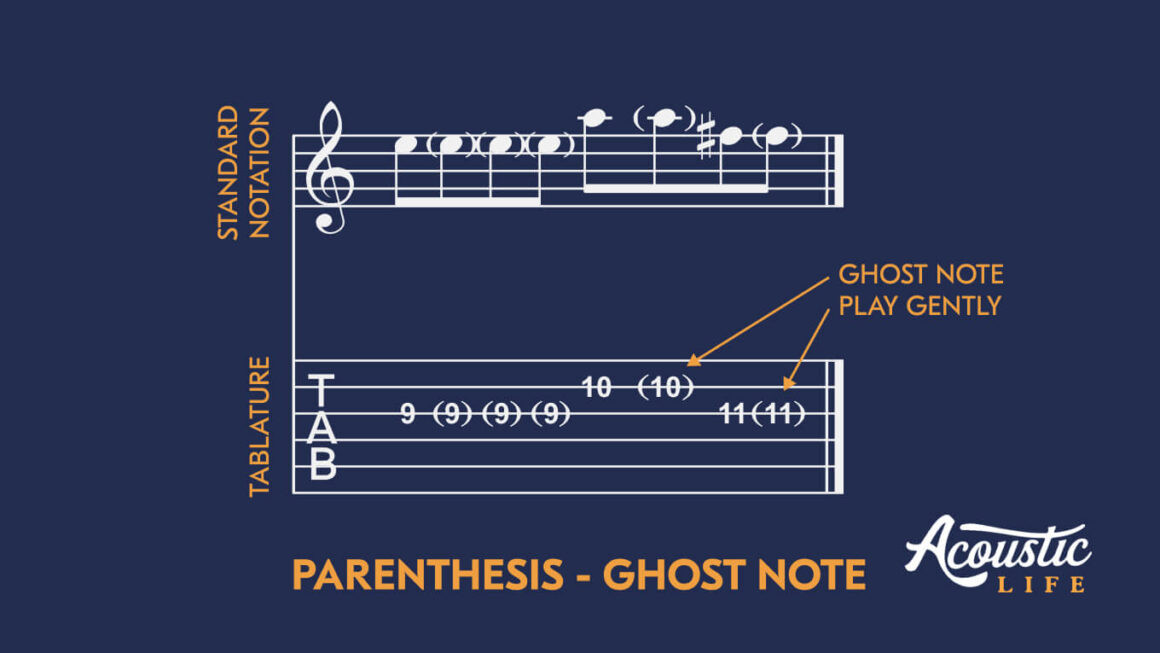 Example of Parentheses for Ghost Notes in Guitar Tabs
Example of Parentheses for Ghost Notes in Guitar Tabs
- Let Ring: Parentheses can also indicate that a note should continue to ring or sustain until the next note or musical bar.
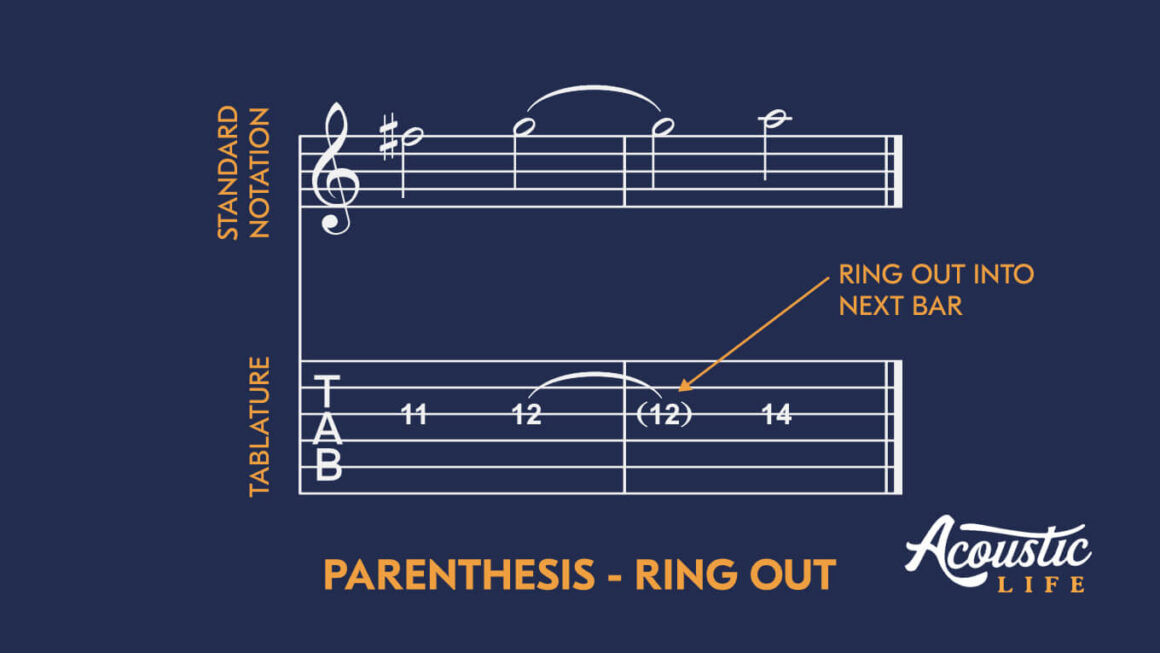 Example of Parentheses for Let Ring in Guitar Tabs
Example of Parentheses for Let Ring in Guitar Tabs
Context usually clarifies whether parentheses represent ghost notes or sustain.
7. Vibrato (~)
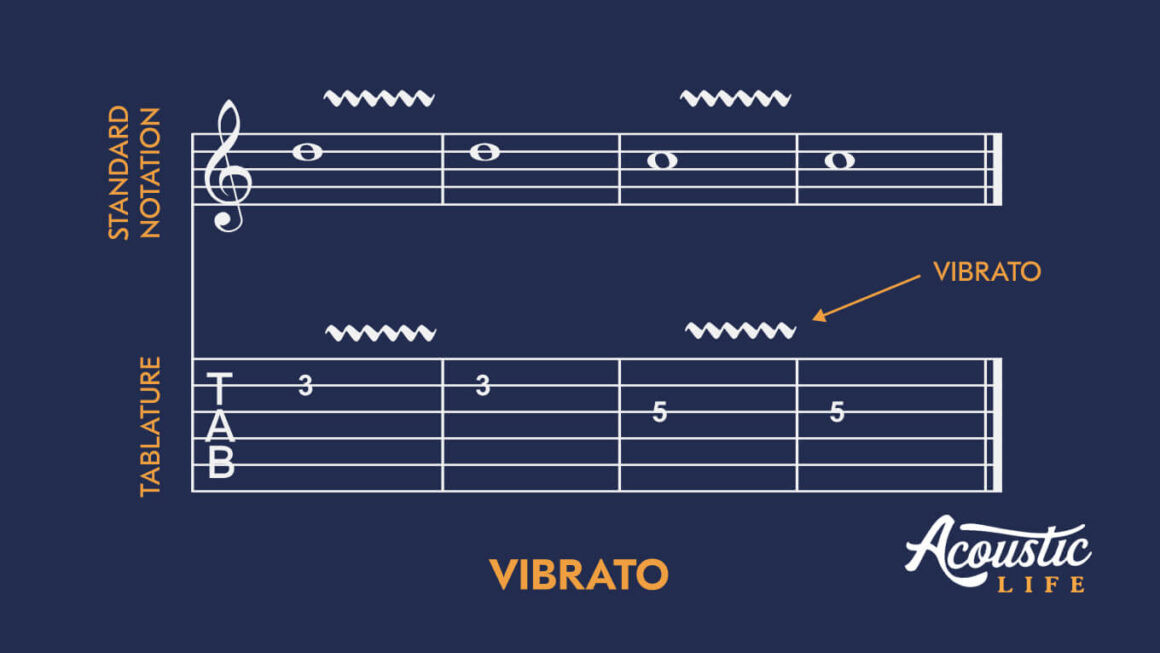 Example of Vibrato Symbol in Guitar Tabs
Example of Vibrato Symbol in Guitar Tabs
The vibrato symbol “~” indicates vibrato, a slight, rapid variation in pitch that adds warmth and expression to a note. It’s achieved by subtly bending the string back and forth while sustaining the note. The length of the “~” line can sometimes suggest the duration or intensity of the vibrato.
A “~” after a number in a tab means to apply vibrato to that note.
8. Natural Harmonics (<>)
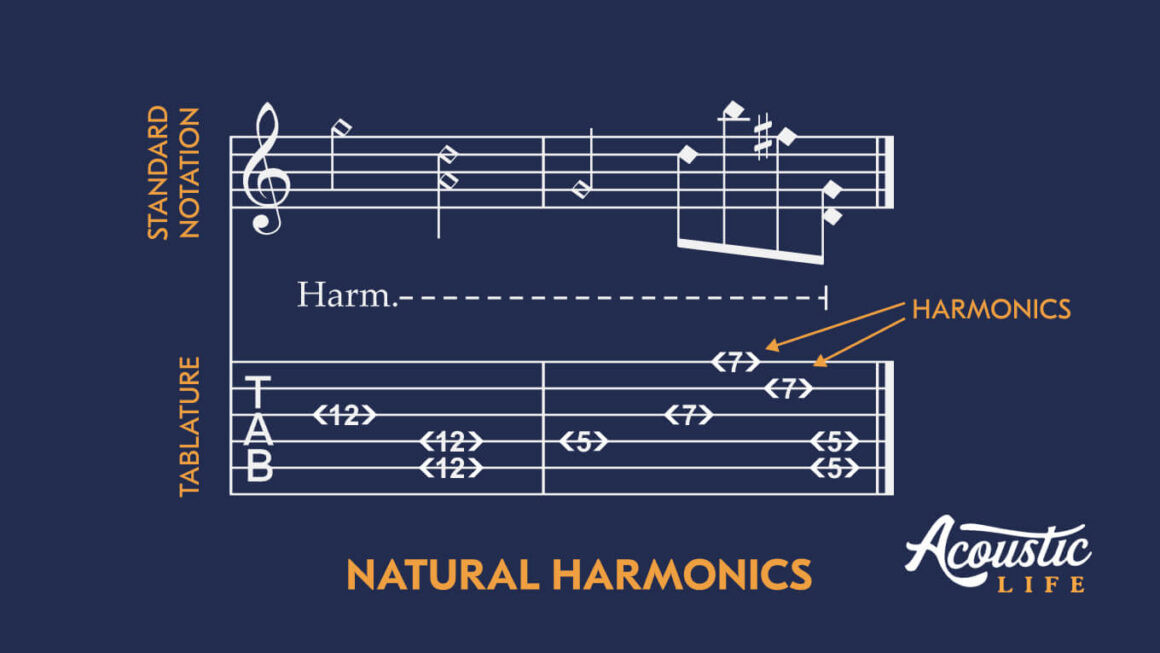 Example of Natural Harmonics Symbol in Guitar Tabs
Example of Natural Harmonics Symbol in Guitar Tabs
Natural harmonics are bell-like tones produced by lightly touching the string directly above certain frets (like the 5th, 7th, and 12th) and picking it. They are often represented by diamond shapes around the fret number or sometimes by brackets “<>”.
“” indicates a natural harmonic at the 5th fret.
9. Tapping (t)
The symbol “t” signifies tapping, a technique where you use a finger from your picking hand to strike a fret on the fretboard, creating a note. It’s often combined with hammer-ons and pull-offs for fast, legato runs.
“12t17” could indicate tapping the 17th fret after playing a note at the 12th fret.
10. Palm Muting (PM)
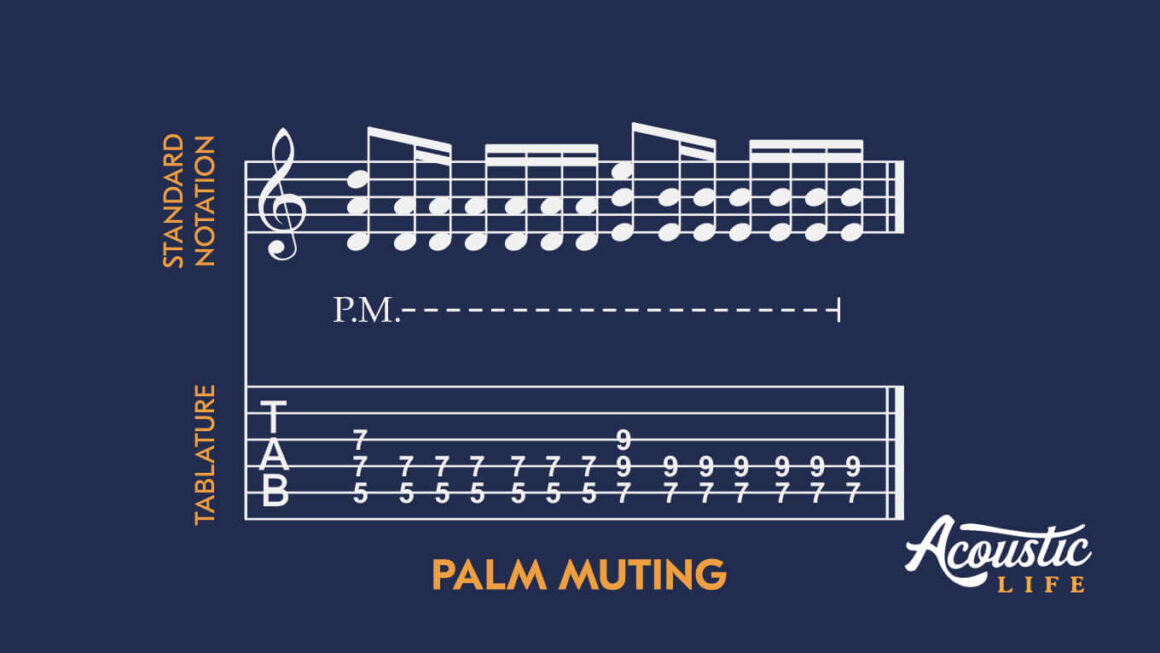 Example of Palm Muting Symbol in Guitar Tabs
Example of Palm Muting Symbol in Guitar Tabs
“PM” stands for palm muting. This technique involves resting the edge of your picking hand palm lightly on the strings near the bridge while picking. It creates a damped, chunkier tone, often used in rock and metal genres. “PM” is usually followed by a dashed line to indicate the duration of the palm muting.
“PM|—| ” over a series of notes indicates to palm mute those notes.
Guitar Tab Symbols Cheat Sheet
For quick reference, here’s a handy table summarizing the guitar tab signs we’ve covered:
| Symbol | Explanation |
|---|---|
| Stacked numbers | Play as a chord (all notes together) |
| Horizontal numbers | Play notes consecutively (melody/riff) |
| 0 | Open string |
| h or ^ | Hammer-on |
| p | Pull-off |
| / | Slide up |
| Slide down | |
| b | Bend |
| x | Mute/Dead note |
| () | Ghost note or Let ring |
| ~ | Vibrato |
| <> | Natural Harmonic |
| t | Tapping |
| PM | Palm Muting |
Mastering Guitar Tab Signs: Your Next Steps
Congratulations! You’ve now unlocked the secrets of guitar tab signs. Like any language, fluency comes with practice. The more you encounter and interpret these symbols in actual songs, the more intuitive they will become.
Start by practicing with simple songs using tabs, and gradually challenge yourself with more complex pieces. Don’t be afraid to revisit this guide whenever you encounter a symbol you’re unsure of.
With a solid understanding of guitar tab signs, you’re well-equipped to explore a vast library of guitar music and elevate your playing to new heights. Happy playing!
